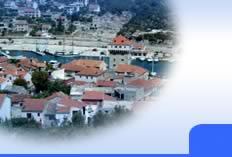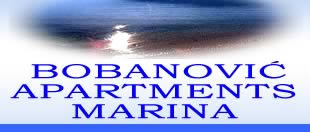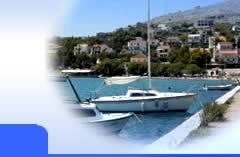


Near Marina, turists can see lots of atractive places like the National Park "Slapovi rijeke Krke" and the cities Split and Trogir.
MARINA, a village and small harbour in the interior part of the Marina bay, 12 km west of Trogir; population 897. The coasts of the Marina bay are very well indented, with a number of small coves with sand and pebble beaches. Marina is located on the main road(M2, E65). Small yachts may dock within the small harbour and are protected from all winds; larger yachts may dock at the end of the
bay, southeast of the chapel and south of the Plokata hill. The settlement was planned in the 16th century. In the period 1495-1500 the bishops of Trogir built a quadrangular tower on the islet in the bay. The tower has console battlements (the channel between the mainland and the tower was filled up and levelled at the beginning of the 20th c.); the structure was repaired during the Candian war in 1657 and 1717; reconstructed in 1971/1972. The church of St. John has Gothic and Renaissance elements. In the field close to the village there is a small Gothic church of St. Luke with the coat of arms of the Sobota family. Major tourist attractions of Marina are a nice sand beach in the shade of olive and pine trees, the atmosphere of ancient Dalmatian wine cellars, fresh fish and quality local wines, a blend of the ancient and the modern. Sportsmen and recreation enthusiasts may enjoy yachting, diving and fishing. Boats and yachts are rented. Entertainment and cultural programs are offered in the nearby towns of Trogir and Split. The Marina riviera comprises Vinisce, Poljica and Sevid, small places with accommodation facilities. Agana Marina: in Marina has 140 berths in the sea and 100 places on the land.
TROGIR, a town and harbour on the coastal strip of the Kastela Gulf, 27 km west of Split; population 10,266. The old core is situated on a small island between the island of Ciovo and the mainland; connected with the mainland by a small stone bridge, and with the island of Ciovo by a drawbridge. The town spreads to the northern coast of Ciovo, opposite the small island. Chiefoccupations include shipbuilding, tobacco, pharmaceuticals and tourist trade. Trogir lies on the main road
(M2, E65). Split Airport is in nearby Resnik. Trogir Marina is situated on the northern coast of the Ciovo island, between the bridge of Trogir and Cape Cubrijan. Trogir is a town-museum in the very meaning of the word. Lovers of cultural and historical monuments, art, original architecture and nice alleys are given the opportunity in Trogir to learn about the manifold and complex heritage - from the Romanesque yard to the modern interiors. The unique his-tori-cal core, Radovan's portal, the art collections which have been arousing excitement among visitors and travellers for centuries offer a tourist beauty, personified in the relief of Kairos as an appropriate souvenir. The wider surroundings of Trogir (Trogir - Seget - Ciovo Riviera) is characterized by lavish green vegetation, numerous islands and islets, rocky and pebble beaches. Apart from the high quality accommodation - hotels, boarding houses, apartments, campsites, delicious domestic food, fish dishes in par-ticular, the sports and recreation offer includes many opportunities - tennis, boccia, bowling, jogging, surfing school, diving. Entertainment includes lively fishermen's nights and folklore show but also classical music concerts in special scenic sets of the town. Trogir ACI Marina has 200 berths in the sea and 80 places on the land.
SLAPOVI KRKE, the Krka National Park is a spacious, largely unchanged region of exceptional and multifaceted natural value, and includes one or more preserved or insignificantly altered ecosystems. It is intended primarily
for scientific, cultural, educational, recreational, and tourism activities such as visiting and sightseeing. It was proclaimed a national park in 1985 and is the seventh national park in Croatia. The Krka National Park is located entirely within the territory of Šibenik- Knin County and encompasses an area of 109 square kilometers along the Krka River: two kilometers downriver from Knin to Skradin and the lower part of the Čikola River. From the flooded part of the mouth, it is 72.5 kilometers in length, making the Krka the 22nd longest river in Croatia. The source of the Krka River is at the base of the Dinaric Mountains, 3.5 kilometers northeast of the base ofKnin and
22 meters below Topoljski Slap, Veliki Buk andKrčić Slap, which are noisy cascades in the winter but run dry during the summer. The length of the freshwater section of the river is 49 kilometers and that of the brackish section is 23.5 kilometers. Significant tributaries of the Krka River include Krčić, Kosovčica, Orašnica, Butišnica and Čikola with Vrb. With its seven travertine waterfalls and a total drop of 242 meters, the Krka River is a natural and karstic phenomenon.
SPLIT, a city and port in Central Dalmatia. Situated on a peninsula between the eastern part of the Gulf of Kastela and the SplitChannel. A hill, Marjan (178 m), rises in the western part of the peninsula. The ridges Kozjak (780 m) and Mosor (1,330 m) protect the city from the north and northeast, and separate it from the hinterland. Split is one of the sunniest places in Europe. Split is not only an urban, cultural and traffic centre of Dalmatia with road and sea connections to Dalmatia's numerous summer resorts, but it is itself often a tourist and excursionists destination. A city with a 1700-year old tradition, a variety of archaeological, historical and cultural monuments, among which the well-known Palace of Diocletian, inscribed into the UNESCO World Heritage List, certainly occupies a special position, and the warmth and offer of a modern Mediterranean city. The first detailed tourist guidethrough the town and its surroundings, published in 1894, bears witness to the long tourist tradition in Split. To be able to grasp thehistorical significance of the city, one should first visit the museums of Split: the Museum of Croatian Archaeological Monuments - a capital Croatian cultural project, established in 1893 in Knin; the Archaeological Museum from 1820, one of the oldest in Croatia; the Treasury of the Split Cathedral, including a valuable collection of religious art; the Ethnographic Museum, founded in 1910; the Museum of Marine History; the Museum of Natural Science. The Art Gallery, established in 1931, the Collection of the Franciscan Monastery in Poljud, the Mestrovic Gallery, and other are also worth visiting. Split is a major sports centre (the 1979 Mediterranean Games) with many famous and popular sports clubs and competitors. There are also many sports facilities for recreational
purposes. Worth visiting is Marjan Forest Park, the green oasis the citizens of Split have been proud of for generations, carefully maintained and cherished. The park includes promenades, vista points, solariums, nature paths, playgrounds and the Split zoo. A marvellous view is offered from the top of Marjan on the old and new parts of Split. It takes only 15 minutes of pleasant walking to reach Marjan from the historical core of Split through the old quarter Varos. The Marjan stairway, running along the crest of the hill, leads to another, higher top of Marjan, Telegrin, with a vista point offering prospect on the Split peninsula, Kozjak, Mosor, the Kastela Gulf, Salona and Klis, Trogir and Ciovo, and the islands of Solta, Brac, Hvar and Vis. The southern cliffs of Marjan represent in recent times a very good training ground for mountaineers and free climbers, who gather here every April on the occasion of the traditional Marjan Cup. The cultural and entertainment offer of Split is extremely rich, particularly in the summer, when the city squares, yards and other areas turn into a large open-air stage. The Split Summer, a traditional festival in the middle of the summer season, includes dramas, operas and concerts (from mid-July to mid-August). The Split Saturday Nights are de-voted to classical music. Split also hosts pop-music events, the Art-Summer, folklore shows, the folk feast Day of Radunica, and many other.